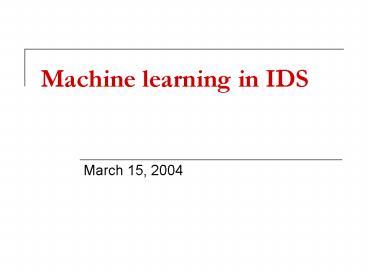Machine learning in IDS - PowerPoint PPT Presentation
1 / 23
Title:
Machine learning in IDS
Description:
Utilized the Solaris SHIELD Basic Security Module (BSM) for user audit data. Perl script parsed the BSM data into separate audit files for four different users ... – PowerPoint PPT presentation
Number of Views:44
Avg rating:3.0/5.0
Title: Machine learning in IDS
1
Machine learning in IDS
- March 15, 2004
2
Source Papers
- T. Lane and C. E. Brodley An application of
machine learning to anomaly detection, NIST-NCSC
National Information Systems Security Conference,
1997 - J. Ryan, M. Lin, R. Miikkulainen Intrusion
Detection with Neural Networks, MIT Press, 1998 - A. K. Ghosh, A. Schwatzbard and M. Shatz Learning
Program Behavior Profiles for Intrusion
Detection, USENIX Workshop on Intrusion Detection
and Network Monitoring, 1999 - D. Endler Intrusion detection Applying machine
learning to solaris audit data, ACSAC'98
3
Two Major Approaches
- Misuse detection define intrusions ahead of
time and watch for their occurrence - Can detect well-known attacks via patterns
- Future attacks cannot be preemptively detected
- Anomaly detection detect behavior that deviates
from normal system use - Learn a normal system activity profile
- Can abstract information about normal behavior to
detect attacks
4
Basic Terminology
- Concept Drift behavioral changes undergone by
valid users during normal use - On-line systems
- Run in real-time with users
- Computationally expensive
- Off-line systems
- Run against stored user data at a scheduled time
- Cannot respond in real-time
5
Paper 1
- IDS must learn characteristic sequences of
actions - These sequences differ on a per-user basis
- Characteristic differences between these
sequences differentiate valid users from
intruders - Use the sequence as the fundamental unit of
comparison - Omit filenames for privacy and focus on behavior
instead of content
6
Paper 1
- Parse the command stream into a token stream
- gt ls laf
- gt cd /tmp
- gt gunzip c foo.tar.gz (cd \ tar xf -)
- becomes
- ls laf cd lt1gt gunzip c lt1gt ( cd lt1gt tar -
lt1gt ) - This token stream is stored in the dictionary,
along with a similarity measure and a set of
system parameters
7
Paper 1
- Compute a numerical similarity measure for pairs
of sequences that have close resemblance
8
Paper 1
- Collected data from four users
- Experimented with different analysis methods
- Sequence length had a major effect on accuracy
- Dictionary must be kept small to avoid false
positives, and for performance reasons - The problem of informed, malicious users
- The system performed well, some caveats
- No concept drift
- Novice users
9
Paper 2
- Describes the NNID (Neural Network Intrusion
Detector) - Works off-line, identifies behavior using the
distribution of commands a user executes - Selected 100 commands to describe the users
behavior
10
Paper 2
- A machine was selected that had 10 users, for a
total of 89 user-days - The network was trained on 8 randomly chosen days
of data and then tested against the remaining 4
days of data - Two separate tests were run
- Identifying remaining vectors
- Identifying randomly-generated vectors
11
Paper 2
- Identified user vectors 93 of the time
- False alarm rate of 7
- Rejected 63 of the random user vectors
- Had an anomaly detection rate of 96
- All the false alarms were the same user, and were
attributed to lack of data
12
Paper 2
- Overall, the system was a success
- How well does the system scale with more users?
- To what extent does user behavior change over
time?
13
Paper 3
- Three algorithms were experimented with
- Table lookup
- Backpropagation network
- Elman network
- These three algorithms range from memorization to
generalization
14
Paper 3
- Equality matching is simple but effective
- Data is partitioned into fixed-size windows
- For analysis, data is compared to a ROC (Receiver
Operating Characteristics) curve - This curve is essentially an intrusive measure
that calculates the probability of intrusion
15
Paper 3
- A backpropagation network attempts to learn from
network behavior - Multiple networks were trained for each program,
and the best was kept - Networks were fed random data to generalize
everything as anomalous - Allows single anomalies, but recognizes sequences
of anomalies
16
Paper 3
- An Elman network can recognize recurrent features
in the input - Perform classification of short sequences of
events as they occur within a larger stream of
events - The Elman network was the least tuned, but most
successful
17
Paper 3
- Overall results
18
Paper 4
- Utilized the Solaris SHIELD Basic Security Module
(BSM) for user audit data - Perl script parsed the BSM data into separate
audit files for four different users
19
Paper 4
- Testing data consisted of normal sessions,
interspersed with simulated account break-ins - Number of signal features was reduced to 13 from
488 - Ideal window size was determined to be 6
20
Paper 4
21
Paper 4
- Ultimately, the best solution was a combination
of both anomaly and misuse detection
22
Common Problems
- If an intruder can breach the system during the
learning phase, the system can learn the
malicious behavior - All tests were performed against low user numbers
- No real-world testing was performed
23
Summary
- Creating system usage fingerprints is a valid
methodology for IDS - Systems can be run both on-line and off-line
depending on the configuration needed - Real-world testing required before implementation































